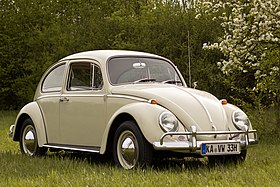| Volkswagen Type 1 "Beetle" | |
|---|---|
 1965–1966 Volkswagen Käfer | |
| Overview | |
| Manufacturer | Volkswagen |
| Also called |
|
| Production | 1938–2003 21,529,464 produced |
| Designer | Ferdinand Porsche |
| Body and chassis | |
| Class | Small family car |
| Body style |
|
| Layout | Rear-engine, rear-wheel-drive |
| Powertrain | |
| Engine | |
| Transmission |
|
| Dimensions | |
| Wheelbase | 2,400–2,420 mm (94.5–95.3 in) |
| Length | 4,079–4,140 mm (160.6–163.0 in) |
| Width | 1,539–1,585 mm (60.6–62.4 in) |
| Height | 1,500 mm (59.1 in) |
| Kerb weight | 730–930 kg (1,610–2,050 lb) |
| Chronology | |
| Successor | |
The Volkswagen Beetle, officially the Volkswagen Type 1,[a] is a small family car produced by the German company Volkswagen from 1938 to 2003.[b] One of the most iconic cars in automotive history, the Beetle is noted for its distinctive shape. Its production period of 65 years is the longest of any single generation of automobile,[c] and its total production of over 21.5 million is the most of any car of a single platform.
The Beetle was conceived in the early 1930s. The leader of Nazi Germany, Adolf Hitler, decided there was a need for a people's car—an inexpensive, simple, mass-produced car—to serve Germany's new road network, the Reichsautobahn. The German engineer Ferdinand Porsche and his design team began developing and designing the car in the early 1930s, but the fundamental design concept can be attributed to Béla Barényi in 1925, predating Porsche's[d] claims by almost ten years. The result was the Volkswagen Type 1 and the introduction of the Volkswagen brand. Volkswagen initially slated production for the late 1930s, but the outbreak of war in 1939 meant that production was delayed until the war had ended. The car was originally called the Volkswagen Type 1 and marketed simply as the Volkswagen. It was not until 1968 that it was officially named the "Beetle".
Volkswagen implemented designations for the Beetle in the 1960s, including 1200, 1300, 1500, 1600, 1302, and 1303. Volkswagen introduced a series of large luxury models throughout the 1960s and 1970s—comprising the Type 3, Type 4 and the K70—to supplement the Beetle, but none of these models achieved the level of success that it did. Rapidly changing consumer preferences toward front-wheel drive compact hatchbacks in Europe prompted Volkswagen's gradual shift away from rear-wheel drive, starting with the Golf in 1974. In the late 1970s and '80s, Japanese automakers began to dominate the market, which contributed to the Beetle's declining popularity.
Over its lifespan, the Beetle's design remained consistent, yet Volkswagen implemented over 78,000 incremental updates. These modifications were often subtle, involving minor alterations to its exterior, interior, colours, and lighting. Some more noteworthy changes included the introduction of new engines, models and systems, such as improved technology or comfort.
- ^ Meredith, Robyn (4 January 1998), "With New Beetle Come Wistful Hints of Old Flame", The New York Times, archived from the original on 17 January 2024, retrieved 16 February 2024
- ^ Faragher 2005, p. 7.
- ^ Dowling, Joshua (13 July 2019), "Bye-bye Beetle, thanks for the memories", The Age, archived from the original on 14 July 2019, retrieved 14 March 2024
- ^ Dorger, Samanda (27 December 2021), "The Car Models That Have Been Around the Longest", TheStreet, archived from the original on 24 December 2023, retrieved 16 February 2024
Cite error: There are <ref group=lower-alpha> tags or {{efn}} templates on this page, but the references will not show without a {{reflist|group=lower-alpha}} template or {{notelist}} template (see the help page).